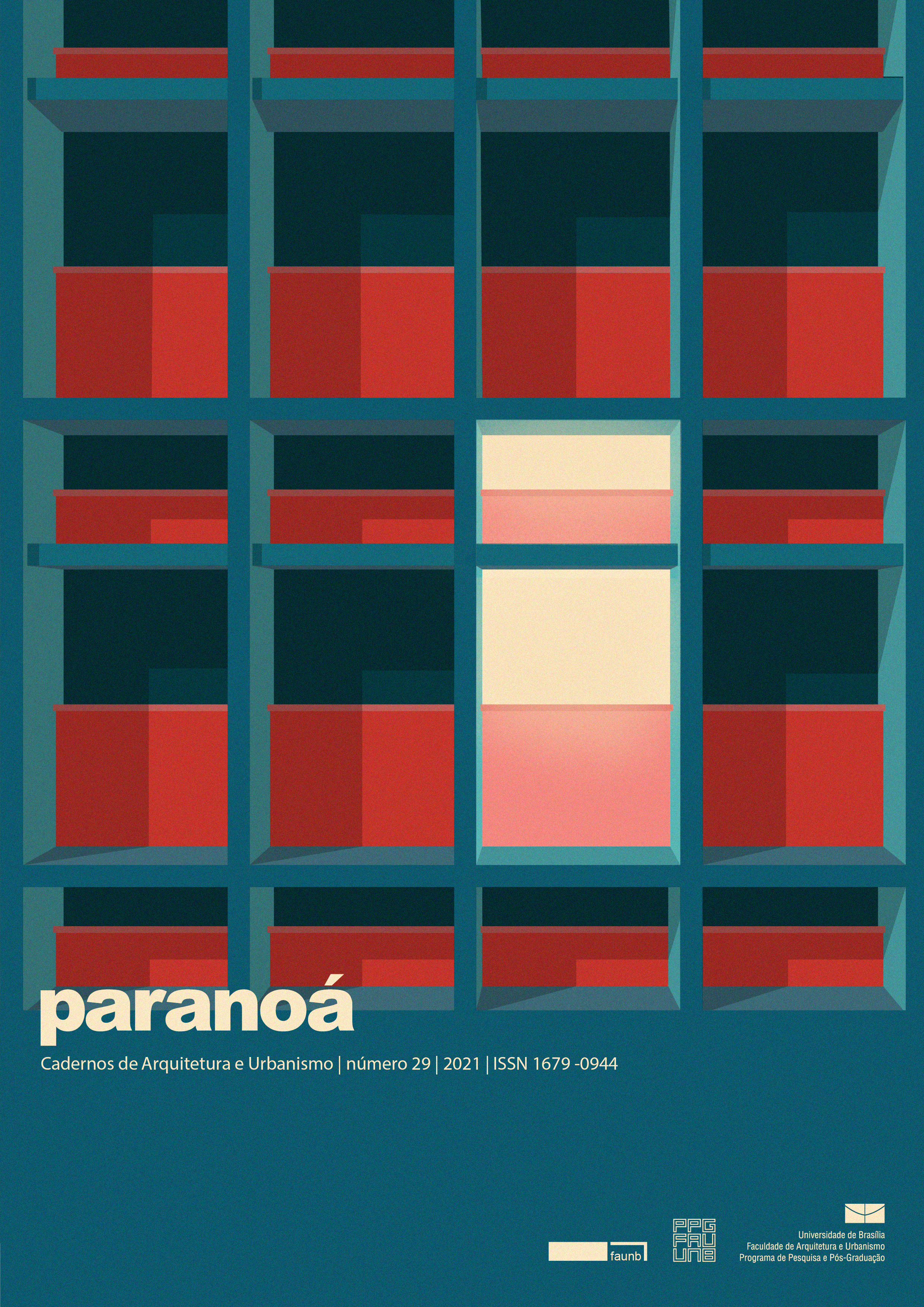Performance luminosa da associação entre elemento vazado, janela alta e prateleira de luz
DOI :
https://doi.org/10.18830/issn.1679-0944.n29.2021.11Mots-clés :
desempenho lumínico; elementos vazados; janela alta; prateleira de luz; simulação computacionalRésumé
Esta pesquisa teve como objetivo investigar a performance luminosa da associação entre elemento vazado, janela alta e prateleira de luz para um ambiente interno de escritório em localidade de clima tropical úmido. Na metodologia foram feitas modelagens com o Rhinoceros3D+Grasshopper e simulações com o DIVA-for-Rhino. Como parâmetros de análises adotou-se os intervalos da UDI (Useful Daylight Illuminances), a Autonomia da Iluminação Natural (DA) e a Uniformidade. As avaliações foram feitas para Norte e Oeste para os seguintes modelos: Modelo I (elemento vazado), Modelo II (elemento vazado + janela alta) e Modelo III (elemento vazado + janela alta + prateleira de luz). Utilizando como base o Modelo III foram avaliados mais quatro modelos variando a profundidade interna da prateleira de luz. Os resultados apontaram a dificuldade de os modelos alcançarem os limites mínimos de DA (500lx) e de Uniformidade (0,6), indicando tanto a necessidade de acionamento da iluminação artificial como a existência de elevados contrastes luminosos. O Modelo III10 para Norte e o Modelo III30 para Oeste obtiveram a melhor performance em relação à UDI, garantindo iluminação adequada em cerca de 70% das horas, iluminando de maneira mais eficiente a região profunda do ambiente e admitindo baixos percentuais de iluminação excessiva.
Téléchargements
Références
ABNT ASSOCIAÇÃO BRASILEIRA DE NORMAS TÉCNICAS. NBR 15215-4. Iluminação natural: verificação experimental das condições de iluminação interna de edificações: método de medição. Rio de Janeiro, 2005.
ASSOCIAÇÃO BRASILEIRA DE NORMAS TÉCNICAS (ABNT). NBR ISO/CIE 8995-1. Iluminação de ambientes de trabalho – Parte 1: interior. Rio de Janeiro: ABNT, 2013.
BAKER, N.; FANCHIOTTI, A.; STEEMERS, K. Daylighting in Architecture – A European Reference Book. London: EarthscanLtd. 2010.
BOLSSONI, G.; LARANJA, A. Análise do desempenho lumínico de ambientes internos a partir da atuação de elementos vazados. XV Encontro Nacional de Conforto no Ambiente Construído (ENCAC) e XI Encontro Latino-Americano de Conforto no Ambiente Construído (ELACAC). João Pessoa, 2019a.
BOLSSONI, G.; LARANJA, A. A Influência da Refletância dos Elementos Vazados no Desempenho Lumínico. II Congesso Internacional de Arquitetura e Cidade (ARQCIDADE) e X Coletânea ARQURB. Vila Velha, 2019b.
CARTANA, R.; PEREIRA, F. MAYER, A. Estudo piloto para elementos de controle solar desenvolvidos com modelagem paramétrica e fabricação digital. Ambiente Construído, v. 18, n. 3, p. 67-82, Porto Alegre, 2018.
CHING, F. D. K. Dicionário visual de arquitetura. São Paulo: Martins Fontes, 2010.
FIGUEIRÓ, M. A Luz e a Sua Relação Com a Saúde. Lume, São Paulo, v. 8, n. 44, jun. 2010.
FREEWAN, A. A. Maximizing the light shelf performance by interaction between lightshelf geometries and curved ceiling. Energy Conversion and Management, n.51, p.1600-1604, 2010.
FREEWAN, A. A. Y. Impact of external shading devices on thermal and daylighting performance of offices in hot climate regions. Solar Energy, v.102, p. 14-30, 2014.
GONÇALVES, J.; VIANA, N.; MOURA, N. Iluminação Natural e Artificial. Procel Edifica. Rio de Janeiro, 2011.
LAMBERTS, R.; DUTRA, L.; PEREIRA, F. O. R. Eficiência energética na arquitetura. 3ª ed. São Paulo, 2014.
LAMBERTS, R.; GHISI, R.; RAMOS, G. Impactos da adequação climática sobre a eficiência energética e o conforto térmico de edifícios de escritórios no Brasil. 49p. Florianópolis: LABEEE, 2006.
MAIOLI, R. Avaliação da influência do dispositivo prateleira de luz no conforto visual em edificação comercial com entorno obstruído. Dissertação (Mestrado) – Programa de Pós-Graduação em Engenharia Civil, Universidade Federal do Espírito Santo, Vitória, 2014.
MARTAU, B. T. A Luz Além da Visão. Lume, v. 7, n. 38, jun. 2009.
MESA, N. A.; CORICA, L.; PATTINI, A. Evaluation of the potential of natural light to illuminate buildings in dense urban environment. A study in Mendoza, Argentina. Renewable Energy, n. 36, p. 2414-2423, 2011.
NABIL, A.; MARDALJEVIC, J. Useful daylight illuminances: A replacement for daylight factors. Energy and Buildings, London: Elsevier, v.38, p. 905 - 913, 2006.
OCHOA, Carlos Ernesto; CAPELUTO, Isaac Guedi. Evaluating visual comfort and performance of three natural lighting systems for deep office buildings in highly luminous climates. Building and Environment, v. 41, n. 8, p. 1128-1135, ago. 2006.
RAPHAEL, B. Active control of daylighting features in buildings. Computer-Aided Civil and Infrastructure Engineering, n.26, p.393-405, 2011.
REINHART, C. F.; WIENOLD, J. The Daylighting Dashboard: A Simulation-based Design Analysis for Daylit Spaces. Building and Environment, v. 46, n. 2, p. 386-396, 2011.
SANTOS, A. J. A Iluminação nos Edifícios: Uma perspectiva no âmbito do conforto ambiental e da eficiência energética. 1a ed. Lisboa: LNEC, 2014.
VITÓRIA. Lei n°. 4821, de 30 de dezembro de 1998. Código de Edificações do Município de Vitória. Vitória, 1998. Disponível em: <https://leismunicipais.com.br/codigo-de-obras-vitoria-es> Acesso em: 17 out. 2019.
Téléchargements
Publié-e
Comment citer
Numéro
Rubrique
Licence
(c) Tous droits réservés Paranoá: cadernos de arquitetura e urbanismo 2021

Cette œuvre est sous licence Creative Commons Attribution 4.0 International.
Autores que publicam nesta revista concordam com os seguintes termos:
- Autores mantém os direitos autorais e concedem à revista o direito de primeira publicação, com o trabalho simultaneamente licenciado sob a Licença Creative Commons Attribution que permite o compartilhamento do trabalho com reconhecimento da autoria e publicação inicial nesta revista. http://creativecommons.org/licenses/by/4.0
- Autores têm autorização para assumir contratos adicionais separadamente, para distribuição não-exclusiva da versão do trabalho publicada nesta revista (ex.: publicar em repositório institucional ou como capítulo de livro), com reconhecimento de autoria e publicação inicial nesta revista.
- Autores têm permissão e são estimulados a publicar e distribuir seu trabalho online (ex.: em repositórios institucionais ou na sua página pessoal) a qualquer ponto antes ou durante o processo editorial, já que isso pode gerar alterações produtivas, bem como aumentar o impacto e a citação do trabalho publicado (Veja O Efeito do Acesso Livre).















